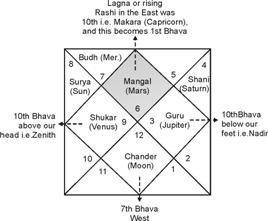Grahas
Let’s analyze the Graha (planets) from Earth's perspective. If you stand facing towards East, after every hour, you will see (if you can) each planet rising one after another. The basic sequence will be Shani (Saturn), Bhraspati (Jupiter), Mangal (Mars), Surya (Sun), Shukar (Venus), Budha (Mercury) and Chander (Moon) from the slowest to the fastest moving planets. This basic sequence gets repeated again an again.
On Saturday, the complete sequence will be Shani (Saturn), Bhraspati (Jupiter), Mangal (Mars), Surya (Sun), Shukar (Venus), Budha (Mercury), Chander (Moon), Shani (Saturn), Bhraspati (Jupiter), Mangal (Mars), Surya (Sun), Shukar (Venus), Budha (Mercury), Chander (Moon), Shani (Saturn), Bhraspati (Jupiter), Mangal (Mars), Surya (Sun), Shukar (Venus), Budha (Mercury), Chander (Moon), Shani (Saturn), Bhraspati (Jupiter) and Mangal (Mars). After Mangal (Mars), Surya (Sun) is the next planet, which will be rolled on to next day i.e. Sunday and then again the same basic sequence will follow. Refer to fig 3.1 Geocentric view from our perspective.
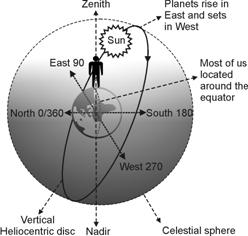
Fig: Geocentric view from our perspective
On Saturday morning, the first rising planet on the East will be Shani (Saturn), thus named as Satur(n)+day. In Vedic Jyotish language, it is also called 1st Hora of Saturday is Shani (Saturn). Essentially this means that Shani (Saturn) rules Saturday. That’s why; remidial measures for Shani (Saturn) carried out on Saturday are more effective.
| Hour | Saturday |
Sunday |
1 (Hora) |
Shani (Saturn) |
Surya (Sun) |
2 |
Bhraspati (Jupiter) |
Shukar (Venus) |
3 |
Mangal (Mars) |
Budha (Mercury) |
4 |
Surya (Sun) |
Chander (Moon) |
5 |
Shukar (Venus) |
Shani (Saturn) |
6 |
Budha (Mercury) |
Bhraspati (Jupiter) |
7 |
Chander (Moon) |
Mangal (Mars) |
8 |
Shani (Saturn) |
Surya (Sun) |
9 |
Bhraspati (Jupiter) |
Shukar (Venus) |
10 |
Mangal (Mars) |
Budha (Mercury) |
11 |
Surya (Sun) |
Chander (Moon) |
12 |
Shukar (Venus) |
Shani (Saturn) |
13 |
Budha (Mercury) |
Bhraspati (Jupiter) |
14 |
Chander (Moon) |
Mangal (Mars) |
15 |
Shani (Saturn) |
Surya (Sun) |
16 |
Bhraspati (Jupiter) |
Shukar (Venus) |
17 |
Mangal (Mars) |
Budha (Mercury) |
18 |
Surya (Sun) |
Chander (Moon) |
19 |
Shukar (Venus) |
Shani (Saturn) |
20 |
Budha (Mercury) |
Bhraspati (Jupiter) |
21 |
Chander (Moon) |
Mangal (Mars) |
22 |
Shani (Saturn) |
Surya (Sun) |
23 |
Bhraspati (Jupiter) |
Shukar (Venus) |
24 |
Mangal (Mars) |
Budha (Mercury) |
Note |
After Mangal (Mars), next Graha (planet) in the sequence is Surya (Sun), which will become the first rising planet on Sunday (Sun + day). This is shown in the next column under the head Sunday. |
After Budha (Mercury), next Graha (planet) in the sequence is Moon, which will become the first rising planet on Monday (Moon + day) and so on. |
Benefic and malefic
In general, Surya (Sun), Mangal (Mars), Shani (Saturn), Rahu (Dragon Head) and Ketu (Dragon Tail) are considered to be malefic planets, where as Bhraspati (Jupiter), Shukar (Venus), Budha (Mercury) and Chander (Moon) are positive.
| # | Sanskrit (English) name |
Type |
1 |
Chander (Moon) |
Benefic |
2 |
Guru (Jupiter) |
Benefic |
3 |
Shukar (Venus) |
Benefic |
4 |
Surya (Sun) |
Malefic |
5 |
Mangal (Mars) |
Malefic |
6 |
Shani (Saturn) |
Malefic |
7 |
Rahu (Dragon Head) |
Malefic |
8 |
Ketu (Dragon Tail) |
Malefic |
9 |
Budha (Mercury) |
Netural |
Depending upon placement a Graha (planet) in a horoscope, Graha (planets) can be benefic or malefic. In-directly malefic Graha (planet) could also create positive effects. For example, Bhraspati (Jupiter) and Shani (Saturn) create expansion and restriction respectively. If Bhraspati (Jupiter) gives us width knowledge, then Shani (Saturn) gives us depth of the knowledge. In other words, Shani (Saturn) acts like a convex lense, which creates focus and makes it practical.
Retrogradation
At times, because of relative motion, it appears that Grahas (planets) are either moving backward or standing still. This is also called retrogradation. Retrogradation happens because the planets orbit more slowly than Earth, and when they are at opposition and we speed past them.
To understand retrogradation, imagine that you are driving your Car “A” at the same speed as other Car “B”, which gives you an illusion that other Car “B” is stationary. If you increase the speed then it will look as if other Car “B” has moved back.

Fig : Retrogradation
Surya (Sun) and Chander (Moon) are exception to retrogression. Rahu (Dragon Head) and Ketu (Dragon Tail) always retrograde i.e. move in reverse.
If a Graha (planet) is retrograded, then nature it’s energy changes to reverse. Genarally retrograded Graha’s (planet) are considered negative. For example if Budha (Mercury) or Mangal (Mars) is retrograde by transit, it is considered as unfavourable time for starting a new activity.
Combustion
At times, because of proximity of Surya (Sun), Graha (planet) losses it’s power and is called as combust Graha (planet). A Graha within 5 degree of Surya (Sun) is in deep combustion and becomes very weak. A Graha (planet) in degree conjunction with Surya (Sun) becomes ineffective.
Sandhi planets
Earlier we discussed that a Graha’s (planet) placement Bhava (arbitrary division of space around Earth) can be measured from 0 to 30 degrees. A Graha (planet) located at 29 to 30 or 1 to 2 degree of Bhavas (arbitrary division of space around Earth) is weak.
Aspects
In relation to the current position, a Graha (planets) can aspect different Bhavas (arbitrary division of space around Earth).
| # | Sanskrit (English) name |
Full aspect on Bhava |
1 |
Surya (Sun) |
7th Bhava |
2 |
Chander (Moon) |
7th Bhava |
3 |
Mangal (Mars) |
7th, 4th and 8th Bhava |
4 |
Budha (Mercury) |
7th Bhava |
5 |
Guru (Jupiter) |
7th, 5th and 9th Bhava |
6 |
Shukar (Venus) |
7th Bhava |
7 |
Shani (Saturn) |
7th, 3rd and 10th Bhava |
8 |
Rahu (Dragon Head) |
7th Bhava |
9 |
Ketu (Dragon Tail) |
7th Bhava |
All Graha (planets) can fully aspect 7th Bhava (arbitrary division of space around Earth) from its current position. Mangal (Mars), Guru (Jupiter) and Shani (Saturn) have been given special aspecting power. Refer to above table and fig 3.3 : Mangal, Guru and Shani Aspects.
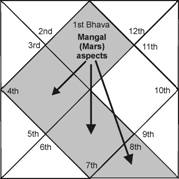
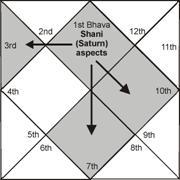
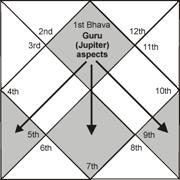
Fig : Mangal, Guru and Shani Aspects
In our previous example, Guru (Jupiter) was in 10th Bhava (arbitrary division of space around Earth). This means that Guru (Jupiter) is exerting its full influence on 2nd, 4th and 6h Bhava (arbitrary division of space around Earth). Please note that shaded 2nd, 4th and 6h Bhava (arbitrary division of space around Earth) are 5th, 7th and 9th from Guru’s (Jupiter) position. Refer to fig 3.4 Guru Aspect.
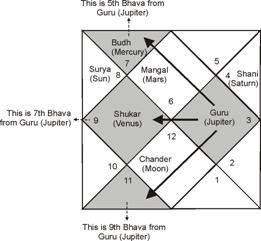
Fig : Guru's Aspect
Graha relationship
In the next few chapters we will discuss that a Graha (planets) owns Bhava (arbitrary division of space around Earth) and Rashi (division of moving group of stars). Imagine that your best friend is staying with you in your own house. Your friend and yourself will be happy, and positive environments will pervail around your house. Similarly in the next chapters, we will decide the effect of relationship on the Kundali (horoscope). Interrelation between Graha (planet) is of the following three types –
| 1 | Naisargika (permanent) |
2 |
Tatkalika (temporary) |
3 |
Naisargika (permanent) + Tatkalika (temporary) |
Naisargika (permanent) is generic relationship between between Grahas (planets). In the following table, Chander (Moon), Mangal (Mars) and friends of Surya (Sun). Budh (Mercury) is netural to Surya (Sun). Shukar (Venus) and Shani (Saturn) are enemies of Surya (Sun) and so on.
| Graha (planet) | Friend |
Netural |
Enemy |
Surya (Sun) |
Chander |
Budha |
Shukar |
Chander (Moon) |
Surya |
Mangal |
None |
Mangal (Mars) |
Surya |
Shukar |
Budha |
Budha (Mercury) |
Surya |
Mangal |
Chander |
Guru (Jupiter) |
Surya |
Shani |
Budha |
Shukar (Venus) |
Budha |
Mangal |
Surya |
Shani (Saturn) |
Budha |
Guru |
Surya |
Rahu |
Budha |
Mangal |
Surya |
Ketu |
Budha |
Mangal |
Surya |
Tatkalika (temporary) relationship varies from Kundali (horoscope) to Kundali (horoscope). Grahas (planet) placed in 2nd, 3rd, 4th, 10th, 11th and 12th become temporary friend of Graha (planet) “A”. Grahas (planet) placed in 1st, 5th, 6th, 7th, 8th and 9th become temporary enemy of Graha (planet) “A”. Refer to fig : 3.5 Temporary friendship.
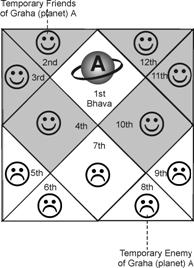
Fig : Temporary friendship
Now lets superimpose the Naisargika (permanent) and Tatkalika (temporary) relationship and derive the final relationship of Kundali (horoscope) in question. This is also called five-fold relationship of Graha (planets).
| Naisargika (Permanent) |
+ |
Tatkalik |
= |
Combination |
Friend |
|
Friend |
|
Best Friend |
Friend |
|
Enemy |
|
Neutral |
Enemy |
|
Enemy |
|
Great Enemy |
Neutral |
|
Friend |
|
Friend |
Neutral |
|
Enemy |
|
Enemy |
Dasha
Dasha (transit) is a period governed by a specific Graha (planet). Dasha (transit) is the time when Krama related to a Graha (planet) will operate. It’s like new Management taking over an existing company, which results in shift in focus, new priorties and new policies. Different Grahas’s (planet) transit period duration is given below -
| # | Sanskrit (English) name |
Dasha (transit) in years |
1 |
Ketu (Dragon Tail) |
7 |
2 |
Shukar (Venus) |
20 |
3 |
Surya (Sun) |
6 |
4 |
Chander (Moon) |
10 |
5 |
Mangal (Mars) |
7 |
6 |
Rahu (Dragon Head) |
18 |
7 |
Guru (Jupiter) |
16 |
8 |
Shani (Saturn) |
19 |
9 |
Budha (Mercury) |
17 |
|
Total |
120 |
Starting of Dasha (transit) varries from Kundali (horoscope) to Kundali (horoscope), which depends upon Chander (Moon) and it’s Nakshtra (asterisms - constellations of fixed stars).
Let’s say that person is mature and now passing through Guru (Jupiter) dasha (transit). In our example, Guru (Jupiter) is well placed in 10th Bhava (arbitrary division of space around Earth) and exerting a positive influence on the Kundali (horoscope). During Guru (Jupiter) dasha (transit), the native will get a job related with teaching. Also later in this book, we will learn that Guru (Jupiter) cause an expansion. So it can be further concluded that the person will get an opportunity to expand his knowledge and responsibility portfolio.
